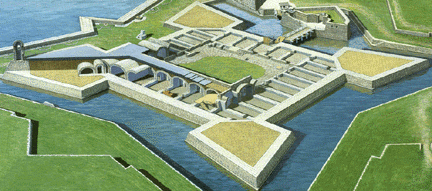Military

Castillo de San Marcos National Monument
Castillo de San Marcos was for many years the northenmost outpst of Spain's vast New World Empire. It is the oldest masonry fort and the best preserved of a Spanish colonial fortification in the continental United States. It anchored East Florida's defenses, which extended northward to the St. Marys River, westward to the St. Johns, and southward to Foret Matanzas. It protected St. Augustine from pirate raids and from Spain's major rival, Great Britain, during a time when the Florida-Georgia-Carolina coastline was an explosive international background.
The roots of the Castillo's history reach back to the years just after Christopher Columbus' discovery of the New World, when conquistadores carved out a vast and wealthy overseas empire for Spain, first in the larger islands of the Carribean and then on the mainlands of Mexico, Central America, Colombia, Venezuela, and Peru. Products of these tropical and mountainous territories brought high prices on the Continent, and Spanish galleons sailed home laden with exotic dyes, sugar, tobacco, chocolate, pearls, hardwood, silver and gold. These so-called "treasure fleets" made Spain the most powerful and envied nation in Renaissance Europe.
Throughout its history, the Castillo de San Marcos has been closely intertwined with the city of St. Augustine and the neighboring structures which served as the city's defense for many years - Fort Mose to the north and Fort Matanzas to the south. The Castillo and St. Augustine serve as outstanding reminders of the might of the early Spanish empire in the New World.
- Boston National Historical Park
- Castillo de San Marcos National Monument
- Castle Clinton National Monument
- Dry Tortugas National Park
- Fort Laramie National Historic Site
- Fort Smith National Historic Site
- Fort Point National Historic Site
- Fort Union National Monument
- Fort Washington Park
- Gateway National Recreation Area
- Golden Gate National Recreation Area
- Gulf Islands National Seashore
- Minuteman Missile NHS (web page under construction)
- San Juan Island National Historical Park
- San Juan National Historic Site
- Sitka National Historical Park
- Springfield Armory National Historic Site